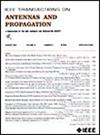A Broadband Dual-Polarized Antenna With Pattern Reconfigurability for Multi-Tag Detection in Chipless RFID
IF 5.8
1区 计算机科学
Q1 ENGINEERING, ELECTRICAL & ELECTRONIC
引用次数: 0
Abstract
Blind source separation (BSS) technology is employed to address anti-collision detection of frequency-coded chipless radio frequency identification (RFID) tags, where multiple mixed backscattering signals are required to be separated. To enable multi-tag detection in chipless RFID, the antenna is required to feature a broad impedance bandwidth, dual polarizations, wide half-power beamwidths (HPBWs), and, most importantly, pattern reconfigurability controlled electrically. To achieve these design goals simultaneously, a pattern reconfigurable antenna with 20 diverse patterns and 100 detection states is proposed over 2.06–6.37 GHz (120%). The proposed antenna is constructed as an antipodal Vivaldi topology, where various patterns are controlled by the switching of diodes. To validate its capability, the proposed antenna is applied to multi-tag detections for 5-bit chipless RFID over 2.0–5.0 GHz. When four chipless tags separated by only 6 mm are present, the proposed antenna can generate various beams to accommodate the number of tags, collecting mixed backscattering signals for the processing using independent component analysis (ICAs). Due to various samples collected with diversity, the mixed signals can be separated and identified into individual IDs, demonstrating the potential of the proposed antenna for multi-tag detection in chipless RFID applications.无芯片RFID中多标签检测的可重构宽带双极化天线
采用盲源分离(BSS)技术解决了频率编码无芯片射频识别(RFID)标签的防碰撞检测问题,该问题需要分离多个混合后向散射信号。为了在无芯片RFID中实现多标签检测,天线需要具有宽阻抗带宽、双极化、宽半功率波束宽度(hpbw),最重要的是,具有电控制的模式可重构性。为了同时实现这些设计目标,提出了一种具有20种不同方向图和100种检测状态的方向图可重构天线,工作频率为2.06-6.37 GHz(120%)。所提出的天线构造为对映维瓦尔第拓扑结构,其中各种模式由二极管的开关控制。为了验证其能力,将所提出的天线应用于2.0-5.0 GHz的5位无芯片RFID的多标签检测。当四个无芯片标签相距仅6毫米时,该天线可以产生各种波束来容纳标签数量,收集混合后向散射信号,使用独立分量分析(ica)进行处理。由于收集的各种样品具有多样性,混合信号可以被分离并识别为单个id,这表明了所提出的天线在无芯片RFID应用中进行多标签检测的潜力。
本文章由计算机程序翻译,如有差异,请以英文原文为准。
求助全文
约1分钟内获得全文
求助全文
来源期刊
CiteScore
10.40
自引率
28.10%
发文量
968
审稿时长
4.7 months
期刊介绍:
IEEE Transactions on Antennas and Propagation includes theoretical and experimental advances in antennas, including design and development, and in the propagation of electromagnetic waves, including scattering, diffraction, and interaction with continuous media; and applications pertaining to antennas and propagation, such as remote sensing, applied optics, and millimeter and submillimeter wave techniques

 求助内容:
求助内容: 应助结果提醒方式:
应助结果提醒方式:


